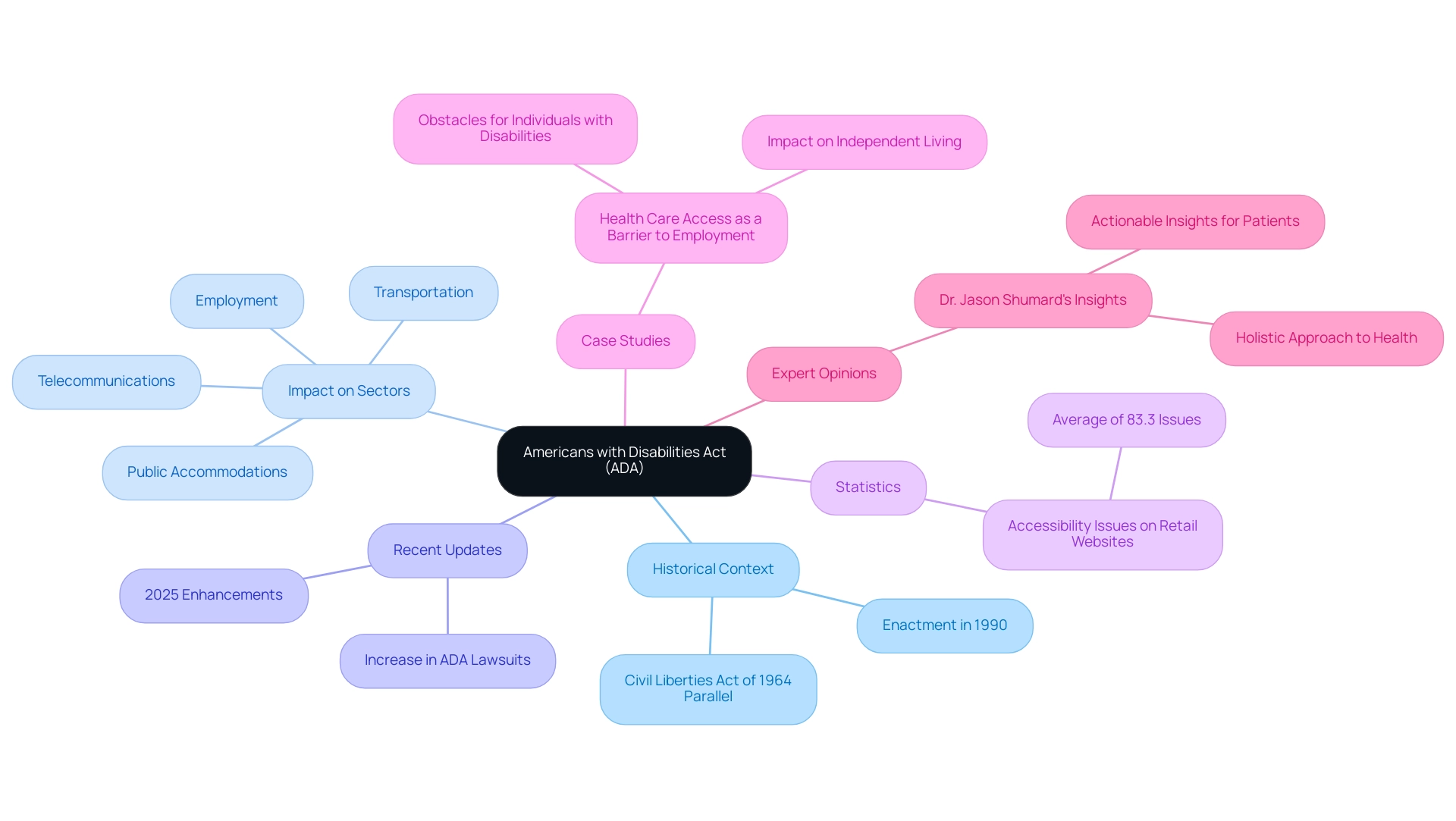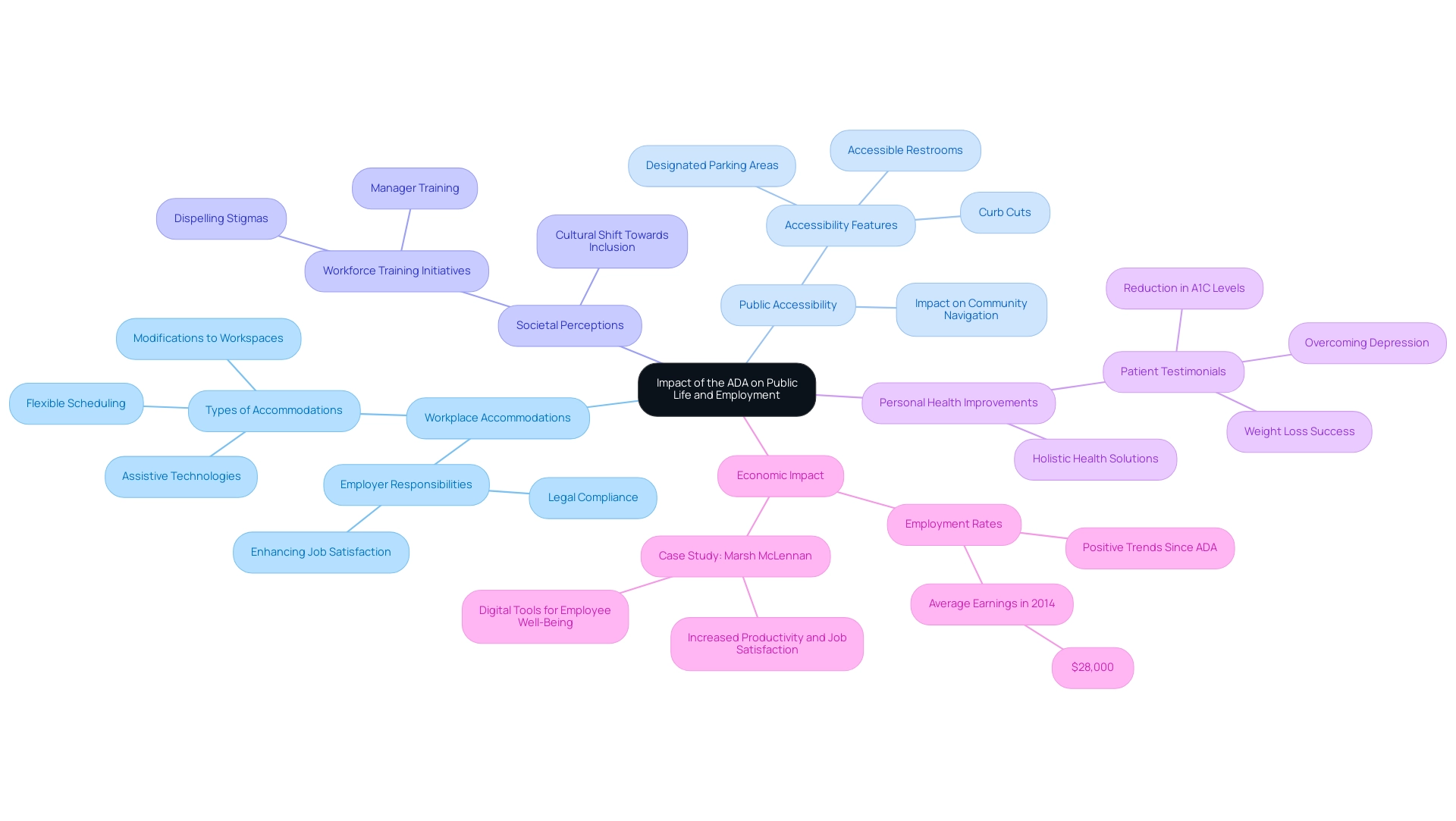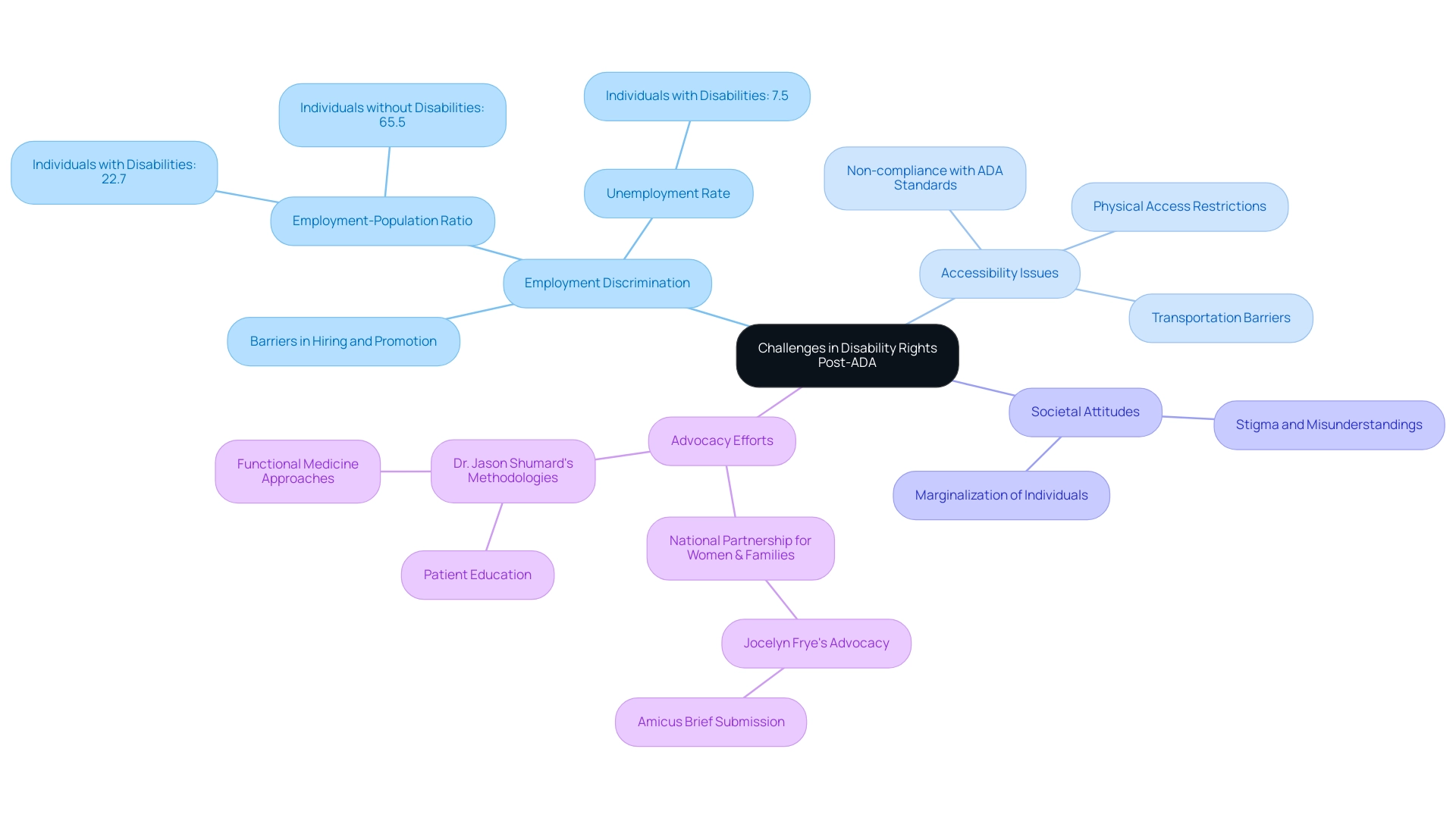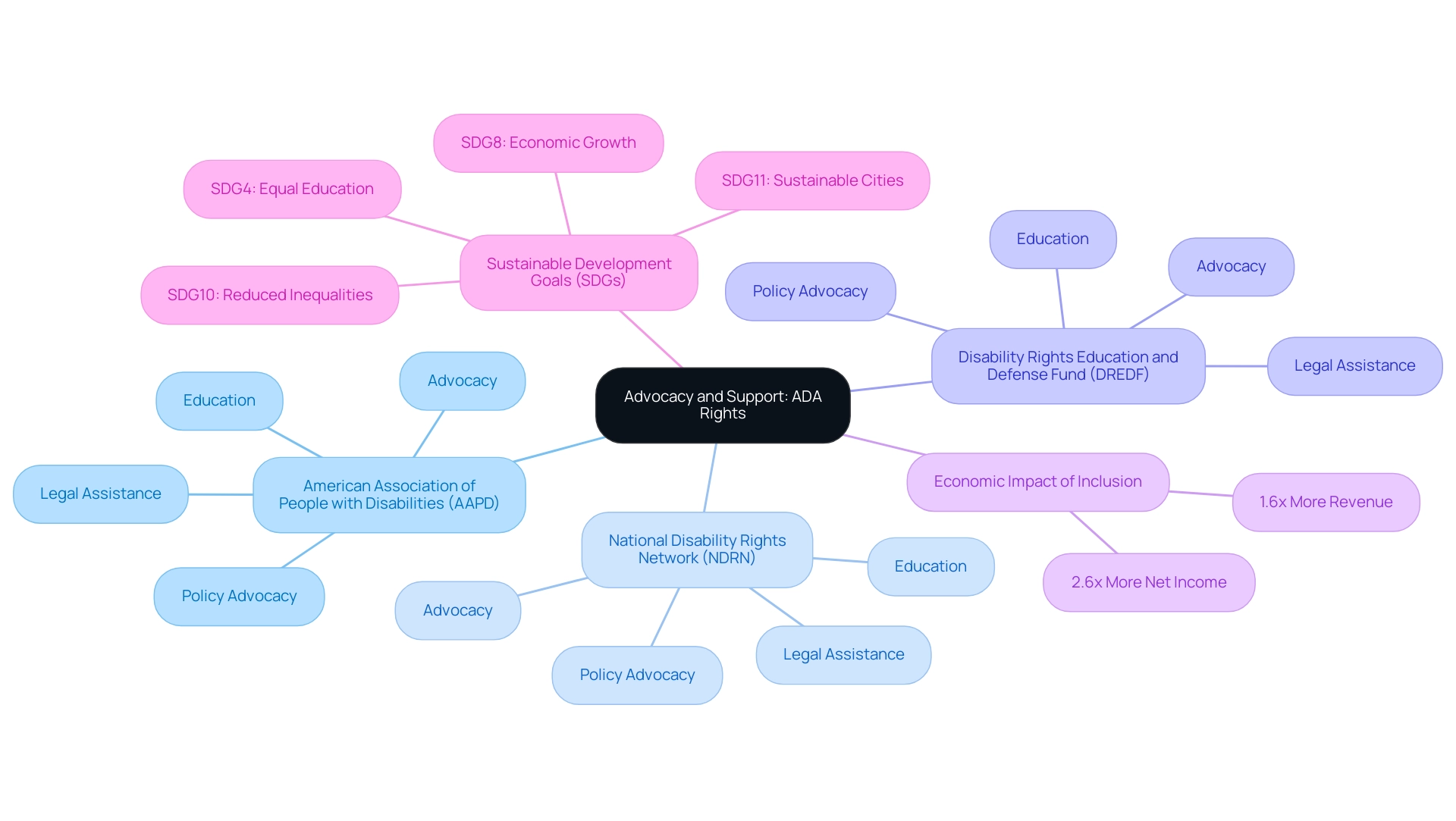Overview
The ADA, or Americans with Disabilities Act, stands as a crucial piece of legislation that protects individuals with disabilities from discrimination and fosters equal opportunities in various areas of public life.
It’s important to recognize how this act has reshaped societal perceptions, enhancing accessibility in both employment and public spaces.
Many individuals find that the ADA not only addresses their immediate needs but also evolves to tackle ongoing challenges, especially for those managing chronic conditions like type 2 diabetes.
This ongoing evolution is a testament to the importance of compassion and understanding in our society.
Introduction
The Americans with Disabilities Act (ADA) represents a significant milestone in the quest for equality for individuals with disabilities. Enacted in 1990, this important legislation not only prohibits discrimination across various sectors but also mandates accessibility, reshaping how society views disability. It’s crucial to recognize that as the ADA evolves, recent updates show a continued commitment to improving accessibility and addressing new challenges, especially for those managing chronic conditions like type 2 diabetes. Many patients find that understanding the ADA’s provisions and their real-world impact is more important than ever, particularly with the rise in ADA-related lawsuits highlighting the ongoing struggle for compliance.
This article will explore the historical context of the ADA, its key provisions, the challenges we still face today, and the essential role of advocacy in promoting disability rights. Together, we’ll paint a comprehensive picture of the ongoing fight for inclusivity and equality, fostering a deeper understanding of this vital issue.
Understanding the Americans with Disabilities Act (ADA)
The legislation known as the ADA name, enacted in 1990, plays a crucial role in prohibiting discrimination against individuals with impairments across various sectors of public life, including employment, transportation, public accommodations, and telecommunications. This landmark legislation was created to ensure that individuals with impairments experience the same privileges and opportunities as their non-impaired counterparts, fundamentally changing societal views on impairment and accessibility. As a civil liberties law, it parallels the Civil Liberties Act of 1964 and has played a crucial role in fostering equality and inclusion for millions of Americans, reflecting the principles of the ADA name.
It’s important to recognize that recent updates to the ADA name legislation in 2025 reflect ongoing efforts to enhance accessibility and address emerging challenges. Statistics indicate that retail and shopping websites currently average 83.3 accessibility issues, which can significantly impact type 2 diabetes patients seeking healthcare resources and information online. Many patients find that the rise in ADA name lawsuits underscores the difficulties businesses face in creating accessible environments, as many still fall short in addressing these critical issues.
Case studies illustrate the ADA’s profound impact on public life. For example, individuals with impairments, including those with type 2 diabetes, often face substantial obstacles to employment due to insufficient access to healthcare and insurance, which the ADA name seeks to alleviate. The absence of accessible healthcare is recognized as a significant barrier to independent living and employment, highlighting the importance of the ADA name in promoting not only entitlements but practical solutions for everyday challenges.
Transformative patient experiences at Integrative Wellness Center highlight the potential for reversing type 2 diabetes through a holistic approach. One patient shared, “I was depressed, no energy, and had insomnia. I hated how I felt and looked. After joining this program, I lost 55 lbs, and my A1C dropped from 9.1 to 5.7. I feel so much better and no longer need my medications!” Another patient noted, “Going through the cleanse helped in so many ways. I have more energy and feel great. I am not depressed anymore!” These testimonials underscore the effectiveness of Dr. Jason Shumard’s methods, which include personalized care, dietary adjustments, and lifestyle changes, in addressing insulin resistance and promoting overall well-being.
Expert opinions on the ADA name’s current condition reveal a consensus on its essential role in promoting equal opportunities for individuals with impairments. Supporters emphasize that the ADA name has played a crucial role in transforming public areas and perceptions while advocating for continual enhancements to ensure that the entitlements of persons with impairments are completely acknowledged. The influence of the ADA name is further emphasized by testimonials from advocates for individuals with impairments, who highlight its importance in promoting a more inclusive society.
Dr. Jason Shumard emphasizes, “By providing patients with actionable insights and practical tools, the center fosters an environment where individuals can reclaim their health and well-being, ultimately leading to improved quality of life and reduced reliance on conventional medical interventions.” This viewpoint is especially significant for type 2 diabetes patients managing the challenges of their condition within the context of advocacy.
In summary, the ADA name remains a cornerstone of access for individuals with impairments, continually evolving to meet the needs of a diverse population. Its successful implementation in various businesses serves as a testament to the progress made while also reminding us of the work that lies ahead in achieving true equality and accessibility for all.
The Historical Context of the ADA
The Americans with Disabilities Act (ADA) emerged from a rich tapestry of advocacy for access that gained significant traction during the 1960s and 1970s. Before the ADA’s enactment, individuals with impairments faced widespread discrimination and exclusion from various aspects of public life, including education, employment, and transportation. This era saw the campaign for access and equality drawing motivation from the civil liberties movement, utilizing demonstrations, legal battles, and community organizing to confront these injustices directly.
Significant occurrences, like the Capitol Crawl protest in 1990, highlighted the urgent need for comprehensive laws to protect the rights of individuals with impairments. During this protest, people with impairments courageously climbed the steps of the United States Capitol, emphasizing the necessity for accessibility and raising awareness of the challenges faced by those with impairments. This determination and resilience were instrumental in shaping public perception and policy.
It’s important to recognize the financial challenges faced by individuals with chronic conditions, including diabetes. For instance, cancer patients were found to be 28% more likely to have past-due credit card payments than those without cancer, illustrating the economic burdens that can accompany chronic health issues. This financial strain can exacerbate the difficulties faced by diabetes patients, making effective treatment options even more critical.
The culmination of these advocacy efforts was the passage of the ADA in 1990, marking a monumental triumph for the movement supporting individuals with disabilities. This significant legislation not only banned discrimination against persons with impairments but also required accessibility in public areas, fundamentally transforming the framework of entitlements and opportunities for millions. As Dr. Jason Shumard emphasizes, “By providing patients with actionable insights and practical tools, the center fosters an environment where people can reclaim their health and well-being.”
This commitment to patient empowerment aligns with the ongoing struggle for equality. Reflecting on the influence of the advocacy movement, it is evident that the ADA serves as a testament to the strength of united efforts. Furthermore, Dr. Shumard’s Functional Medicine Approach, as highlighted in case studies, showcases the center’s impact on patients, empowering them through the 30-Day Diabetes Reset program to manage their diabetes effectively and improve their quality of life. Patients like A.A. have experienced significant transformations, reporting weight loss, increased energy, and a reduction in medication needs, illustrating the potential of holistic care in reversing type 2 diabetes and addressing underlying health issues.
The program has shown promising outcomes, with many participants achieving measurable improvements in their health metrics, further emphasizing the importance of a holistic approach to diabetes management.
Key Provisions and Standards of the ADA
The ada name, known as the Americans with Disabilities Act, is thoughtfully organized into five distinct titles, each addressing vital aspects of public life to protect the rights of individuals with impairments.
- Title I prohibits employment discrimination against qualified persons with impairments, requiring employers to provide reasonable accommodations to support their workforce. This provision is crucial, as many individuals with impairments face significant wage disparities, even when accounting for education and experience.
For instance, workers with impairments often experience a wage gap that can impact their financial stability and access to healthcare.
- Title II mandates that state and local authorities ensure their programs and services are accessible to everyone, fostering inclusivity in public services.
- Title III focuses on public accommodations, requiring businesses to eliminate barriers and ensure equal access to facilities for persons with impairments.
This title plays a vital role in creating an environment where everyone can participate fully in society.
- Title IV addresses telecommunications, ensuring that individuals with hearing or speech challenges have access to essential communication services, thereby enhancing their ability to engage with the world around them.
- Title V encompasses various provisions, including protections against retaliation for individuals who assert their rights under the ADA.
This title reflects the complexity of tackling discrimination, as many individuals with impairments may choose to overlook negative attitudes or struggle to identify them as discriminatory due to a lack of language to express their experiences. This hesitation can discourage them from pursuing legal action under the ADA, highlighting broader societal challenges. Together, these titles form a comprehensive framework that not only protects the rights of persons with impairments but also encourages their full participation in society, as outlined by the ada name.
Practical examples illustrate the effectiveness of these provisions; for instance, reasonable accommodations in the workplace can lead to increased job satisfaction and productivity among employees with impairments.
Expert analysis underscores the significance of ADA compliance, noting that while many organizations strive to meet these standards, challenges persist. The Workforce Innovation and Opportunity Act (WIOA) programs play a crucial role in promoting employment for those with impairments, showcasing current initiatives that support individuals with disabilities in the workforce.
As the ada name evolves, ongoing education and advocacy are essential to ensure that its provisions are effectively implemented, allowing individuals with impairments to thrive in all areas of life. Moreover, as Bungard highlights, with our aging workforce, statistically speaking, if someone doesn’t have a condition now, they will likely age into one. This underscores the importance of the ADA’s provisions for everyone, including those managing chronic issues like type 2 diabetes.
The ADA’s Impact on Public Life and Employment
The Americans with Disabilities Act (ADA) has profoundly changed public life and job opportunities for individuals with impairments, including those managing chronic health conditions like type 2 diabetes. It’s important to recognize that the ADA has opened doors for many to pursue fulfilling careers and make meaningful contributions to the economy. Employers are now required to provide reasonable accommodations, which may include modifications to workspaces, flexible scheduling, and the integration of assistive technologies.
This legal framework not only facilitates employment but also enhances job satisfaction and productivity. Many patients find that having the right support at work makes a significant difference in their daily lives.
In public life, the ADA has dramatically improved accessibility across various domains, including buildings, transportation, and services, thereby fostering a more inclusive society. Features like curb cuts, accessible restrooms, and designated parking areas have become standard, easing navigation for people with impairments within their communities. These changes reflect a broader commitment to inclusivity, ensuring that public spaces are welcoming and usable for everyone.
The ADA’s influence extends beyond mere legal compliance; it has catalyzed a shift in societal perceptions, promoting a culture of inclusion and respect for diversity. For instance, organizations like Marsh McLennan have implemented digital tools aimed at enhancing employee well-being, which not only boosts productivity but also fosters a supportive work environment for over 20,000 employees. Such initiatives exemplify how ADA compliance can lead to improved workplace dynamics and employee satisfaction.
Statistics indicate that employment rates for people with impairments have experienced a positive trend since the ADA’s enactment, with many reporting improved job opportunities and workplace accommodations. In 2014, the average earnings for people with disabilities were $28,000, highlighting the economic impact of the ADA.
Moreover, transformative patient experiences from Dr. Jason Shumard’s 30-Day Diabetes Reset program illustrate the profound impact of holistic health solutions on individuals managing type 2 diabetes. Patients have shared significant improvements in their health, such as one person who lost 55 pounds and reduced their A1C from 9.1 to 5.7. Another individual recounted their journey of overcoming depression and medication dependency through lifestyle changes. These testimonials underscore the importance of personalized guidance and support in reclaiming health and well-being.
As Dr. Jason Shumard states, “By providing patients with actionable insights and practical tools, the center fosters an environment where people can reclaim their health and well-being.” This sentiment resonates with the ongoing improvements in ADA accessibility, which continue to reshape the landscape of employment and public life, reinforcing the importance of inclusivity in all aspects of society, especially for those managing chronic conditions like type 2 diabetes.
Challenges in Disability Rights Post-ADA
Despite significant advancements since the enactment of the Americans with Disabilities Act (ADA), many individuals living with impairments still encounter considerable challenges, especially those managing chronic health conditions like type 2 diabetes. Employment discrimination remains a critical concern, with numerous reports of persistent barriers in hiring processes, promotional opportunities, and job retention. It’s disheartening to note that the employment-population ratio for people with impairments was only 22.7% in 2024, compared to 65.5% for those without impairments, highlighting the stark disparities in workforce participation.
This situation is particularly troubling, as chronic conditions can complicate employment opportunities for those affected. Accessibility issues in public spaces are also prevalent, with many buildings and transportation systems still not fully compliant with ADA standards. This lack of adherence not only restricts physical access but also reinforces societal attitudes that marginalize individuals with impairments. Stigma and misunderstandings surrounding impairments continue to hinder complete inclusion, often leaving people feeling undervalued or overlooked.
Advocacy groups are passionately addressing these challenges, working tirelessly for stronger enforcement of ADA regulations and advocating for enhanced protections. As Jocelyn Frye, President of the National Partnership for Women & Families, stated, “Today, I’m proud to announce that the National Partnership for Women & Families (NPWF) has submitted an amicus brief on behalf of…” Their efforts are crucial in ensuring that individuals with challenges can fully participate in society, underscoring the need for ongoing dialogue and action to combat discrimination and improve accessibility.
As we progress through 2025, it’s important to recognize these challenges and work collaboratively toward a more inclusive future, especially for those managing chronic conditions like diabetes. Dr. Jason Shumard’s innovative methodologies and commitment to patient education are instrumental in empowering individuals to navigate these obstacles, fostering an environment where health and wellness can truly flourish.
Advocacy and Support: Organizations Championing ADA Rights
Many organizations play a crucial role in promoting the entitlements of people with impairments and ensuring adherence to the ADA. The American Association of People with Disabilities (AAPD) and the National Disability Rights Network (NDRN) are among the leading organizations committed to advancing the welfare of individuals with impairments through extensive advocacy, education, and legal assistance. These organizations not only offer crucial resources and training but also empower individuals to navigate the complexities of their rights related to disabilities, allowing them to assert their entitlements and access necessary services.
As we look ahead to 2025, advocacy groups are increasingly focused on enhancing compliance with the ADA and promoting inclusive practices across various sectors. It’s important to recognize that the AAPD actively participates in policy advocacy under the ADA, working closely with legislators to strengthen protections for people with impairments. Their efforts are backed by compelling statistics; organizations prioritizing inclusion for people with disabilities have been shown to achieve 1.6 times more revenue and 2.6 times more net income than their peers. This underscores the economic benefits of inclusivity, a message that resonates deeply with many.
This is particularly relevant for those managing type 2 diabetes, as improved economic conditions can lead to better access to healthcare resources and support. Many patients find that when advocacy efforts succeed, they experience a tangible difference in their daily lives.
Furthermore, the Disability Rights Education and Defense Fund (DREDF) illustrates effective advocacy efforts, offering legal support and educational materials that empower individuals to confront discrimination and assert their rights. The influence of these organizations is further emphasized by case studies, such as ‘The Inclusion Imperative,’ which showcase their effectiveness in advancing equity for individuals with impairments and creating a more inclusive society.
As we consider the future, the role of advocacy organizations in advancing access for individuals with disabilities remains essential. Their dedication to education, legal assistance, and policy advocacy not only improves the lives of those facing challenges but also contributes to a more just society. By persistently engaging with legislators and the community, these organizations are paving the way for a future where the entitlements of individuals with disabilities are recognized and upheld in all areas of life.
Additionally, the Sustainable Development Goals (SDGs) relevant to social inclusion, such as equal education and economic growth, resonate with the interests of people managing chronic conditions like diabetes. This highlights the interconnectedness of health and social equity, reminding us that we are all in this together.
The Future of Disability Rights and the ADA
The journey toward rights for individuals with impairments, particularly through the Americans with Disabilities Act (ADA), is profoundly shaped by ongoing advocacy and the swift advancements in technology. As we look ahead to 2025, digital accessibility emerges as a vital focus, ensuring that individuals with impairments can easily access online services and information, as mandated by the ADA. Current statistics reveal that a staggering 14% of American public school students require some form of assistive technology, highlighting the pressing need for inclusive digital environments.
Moreover, the discussion surrounding mental health and invisible impairments is gaining momentum, fostering a deeper understanding of what constitutes a condition. Advocacy organizations are passionately promoting changes that address these critical issues while enhancing protections and raising awareness of the diverse experiences faced by individuals with disabilities under the ADA. As Jonar Sabilano wisely noted, “Only 3% of the internet is reachable for those with impairments,” underscoring the urgent need for improvement in this area.
It’s important to recognize that enhancing digital accessibility can significantly boost customer engagement, satisfaction, and brand loyalty. Recent case studies indicate that businesses prioritizing web accessibility not only reduce legal risks but also gain a competitive edge in the market. With approximately 20% of top online retailers in the U.S. facing accessibility-related lawsuits in 2022, the necessity for compliance with ADA standards has never been more apparent.
The case study titled “Web Accessibility Statistics and Compliance” reveals how many websites fall short of meeting accessibility standards, resulting in increased lawsuits and lost revenue opportunities.
Looking ahead, expert forecasts suggest that the future of accessibility will embrace a more inclusive approach, blending technology and advocacy to create environments where everyone can thrive. The commitment to advancing disability rights is essential in nurturing a society that values inclusivity and empowers every individual to reach their full potential.
Conclusion
The Americans with Disabilities Act (ADA) has profoundly transformed disability rights since its enactment in 1990. It prohibits discrimination and mandates accommodations for individuals with disabilities, including those managing chronic conditions like type 2 diabetes. This legislation emerged from a rich history of advocacy, showcasing the power of collective action in effecting change.
However, it’s important to recognize that significant challenges remain. Employment discrimination and accessibility issues continue to hinder full inclusion, with only 22.7% of individuals with disabilities participating in the workforce. Advocacy groups play a crucial role in addressing these barriers, providing resources and support to empower individuals to assert their rights.
Many patients find that as the ADA evolves, the focus on digital accessibility and the recognition of invisible disabilities highlight a broader understanding of disability. Organizations are actively working to tackle these emerging challenges, ensuring that the rights of all individuals are upheld.
The path toward true equality and accessibility is ongoing. While the ADA serves as a vital foundation, sustained commitment from society, businesses, and advocacy groups is essential to overcoming obstacles. By fostering an inclusive culture that values diversity, we can enhance the lives of individuals with disabilities and contribute to a more equitable society for everyone.
Frequently Asked Questions
What is the ADA and when was it enacted?
The Americans with Disabilities Act (ADA) was enacted in 1990 and prohibits discrimination against individuals with impairments in various sectors of public life, including employment, transportation, public accommodations, and telecommunications.
What is the purpose of the ADA?
The ADA aims to ensure that individuals with impairments have the same privileges and opportunities as those without impairments, fundamentally changing societal views on impairment and accessibility.
How has the ADA impacted public life?
The ADA has transformed public areas and perceptions, fostering equality and inclusion for millions of Americans, and it has played a crucial role in addressing barriers to employment and healthcare access for individuals with impairments.
What recent updates have been made to the ADA?
Recent updates to the ADA in 2025 reflect ongoing efforts to enhance accessibility and address emerging challenges, particularly concerning the accessibility of retail and shopping websites.
What challenges do individuals with type 2 diabetes face regarding the ADA?
Individuals with type 2 diabetes often encounter significant obstacles to employment due to insufficient access to healthcare and insurance, which the ADA seeks to alleviate.
What are some testimonials from patients regarding diabetes management?
Patients at the Integrative Wellness Center have reported significant health improvements, including weight loss and better management of their diabetes, after participating in holistic care programs.
What do experts say about the current condition of the ADA?
Experts emphasize the ADA’s essential role in promoting equal opportunities for individuals with impairments and advocate for continual enhancements to ensure the entitlements of these individuals are acknowledged.
How does Dr. Jason Shumard view the role of the ADA in healthcare?
Dr. Shumard believes that by providing actionable insights and practical tools, healthcare providers can help individuals reclaim their health and improve their quality of life, particularly for those managing chronic conditions like type 2 diabetes.
What is the significance of advocacy efforts in relation to the ADA?
Advocacy efforts in the 1960s and 1970s were instrumental in the passage of the ADA, highlighting the need for comprehensive laws to protect the rights of individuals with impairments and shaping public perception and policy.
How has the ADA evolved to meet the needs of individuals with impairments?
The ADA continues to evolve by addressing accessibility issues and promoting equality, as evidenced by recent updates and ongoing advocacy efforts aimed at improving access and opportunities for individuals with impairments.



